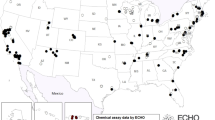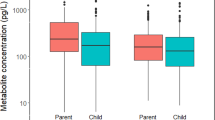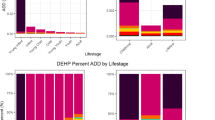Abstract
Characterization of environmental exposures to population subgroups within the National Children’s Study (NCS), or other large-scale human environmental health studies is essential for developing a high-quality data platform for subsequent investigations. A computational formulation utilizing the tiered exposure ranking framework is presented for calculating inhalation exposure indices (EIs) for population subgroups. This formulation employs a probabilistic approach and combines information from diverse, publicly available exposure-relevant databases and information on biological mechanisms, for ranking study locations or population subgroups with respect to potential for specific end point-related environmental exposures. These EIs capture and summarize, within a set of numerical values/ranges, complex distributions of potential exposures to multiple airborne contaminants. These estimates capture spatial and demographic variability within each study segment, and allow for the relative comparison of study locations based on different statistical metrics of exposures. The EI formulation was applied to characterize and rank segments within Queens County, NY, which is one of the Vanguard centers for the NCS. Inhalation EI estimates relevant to respiratory outcomes, and potentially to pregnancy outcomes (low birth weight and preterm birth rates) were calculated at the study segment level. Results indicate that there is substantial variability across the study segments in Queens County, NY, and within segments, and showed an exposure gradient across the study segments that can help guide and target environmental and personal exposure sampling efforts in this county. The results also serve as an example application of the EI for use in other exposure and outcome studies.
This is a preview of subscription content, access via your institution
Access options
Subscribe to this journal
Receive 6 print issues and online access
$259.00 per year
only $43.17 per issue
Buy this article
- Purchase on Springer Link
- Instant access to full article PDF
Prices may be subject to local taxes which are calculated during checkout








Similar content being viewed by others
References
Georgopoulos PG, Brinkerhoff CJ, Isukapalli S, Dellarco M, Landrigan PJ, Lioy PJ . A framework to support characterization and ranking of exposures for the National Children’s Study (NCS). Risk Anal 2012 (under review).
Georgopoulos PG, Isukapalli SS, CCL co-workers. Exposure-based prioritization of a “test set” of environmental chemicals using PRoTEGE (Prioritization/Ranking of Toxic Exposures with GIS Extension). USEPA, the Computational Chemodynamics Laboratory, EOHSI Piscataway, NJ. 2011.
Georgopoulos PG, Wang SW, Vyas VM, Sun Q, Burke J, Vedantham R et al A source-to-dose assessment of population exposures to fine PM and ozone in Philadelphia, PA, during a summer 1999 episode. J Expo Anal Env Epid 2005; 15: 439–457.
Georgopoulos PG, Lioy PJ . From a theoretical framework of human exposure and dose assessment to computational system implementation: the Modeling ENvironment for TOtal Risk Studies (MENTOR). J Toxicol Envirn Health Pt B, Crit Rev 2006; 9: 457–483.
Georgopoulos P . A multiscale approach for assessing the interactions of environmental and biological systems in a holistic health risk assessment framework. Water Air Soil Pollut: Focus 2008; 8: 3–21.
Georgopoulos PG, Isukapalli SS, Burke J, Napelenok S, Palma T, Langstaff J et al Air quality modeling needs for exposure assessment from the source-to-outcome perspective. Environ Manager 2009, 26–35.
Sasso A, Isukapalli S, Georgopoulos P . A generalized physiologically-based toxicokinetic modeling system for chemical mixtures containing metals. Theor Biol Med Model 2010; 7: 17.
USEPA. AirData: Access to Air Pollution Data. US Environmental Protection Agency Washington, DC, (cited 23 August 2011).
USEPA. Exposure Factors Handbook 2011 Edition (Final). US Environmental Protection Agency Washington, DC. 2008 (2011 EPA/600/R-09/052F).
Zhang Y, Lin L, Cao Y, Chen B, Zheng L, Ge RS . Phthalate levels and low birth weight: a nested case-control study of Chinese newborns. J Pediatr 2009; 155: 500–504.
Baibergenova A, Kudyakov R, Zdeb M, Carpenter DO . Low birth weight and residential proximity to PCB-contaminated waste sites. Environ Health Perspect 2003; 111: 1352–1357.
Priyanka C, Dibyendu B . Biomonitoring of air quality in the industrial town of asansol using the air pollution tolerance index approach. Res J Chem Environ 2009; 13: 46–51.
Miranda ML, Maxson P, Edwards S . Environmental contributions to disparities in pregnancy outcomes. Epidemiol Rev 2009; 31: 67–83.
Sram RJ, Binkova B, Dejmek J, Bobak M . Ambient air pollution and pregnancy outcomes: a review of the literature. Environ Health Perspect 2005; 113: 375–382.
Windham G, Fenster L . Environmental contaminants and pregnancy outcomes. Fertil Steril 2008; 89 (2 Suppl): e111–e116 discussion e7.
Behrman RE, Butler AS (eds). Preterm Birth: Causes, Consequences, and Prevention. The National Academies Press Washington, DC. 2007.
NYC DOHMH. New York City Community Air Survey. Results From Year One Monitoring 2008–2009. New York City Department of Health and Mental Hygiene New York, NY. 2009.
USEPA. National Air Toxics Assessments. US Environmental Protection Agency. 2011 (cited 18 October 2011); Available from http://www.epa.gov/nata/.
Lioy PJ, Isukapalli S, Trasande L, Thorpe L, Dellarco M, Weisel C et al Using national and local extant data to characterize environmental exposures in the National Children’s Study (NCS): Queens County, New York. Environ Health Perspect 2009; 117: 1494–1504.
Christakos G . Modern Spatiotemporal Geostatistics. Oxford University Press New York, NY. 2000 p 288.
Cheng WL, Chen YS, Zhang JF, Lyons TJ, Pai JL, Chang SH . Comparison of the revised air quality index with the PSI and AQI indices. Sci Total Environ 2007; 382: 191–198.
Acknowledgements
Support for the work presented here is provided by the National Children’s Study Queens Vanguard Center, which is funded in whole or in part by the National Institute of Child Health and Human Development, National Institutes of Health, under Contract Number 0258-325-4609. Further support is provided by the NIEHS sponsored UMDNJ Center for Environmental Exposures and Disease, under Grant Number NIEHS P30ES005022. The content of this publication does not necessarily reflect the views or policies of the Department of Health and Human Services, nor does mention of trade names, commercial products, or organizations imply endorsement by the U.S. government.
Author information
Authors and Affiliations
Corresponding author
Ethics declarations
Competing interests
The authors declare no conflict of interest.
Additional information
Supplementary Information accompanies the paper on the Journal of Exposure Science and Environmental Epidemiology website
Supplementary information
Rights and permissions
About this article
Cite this article
Isukapalli, S., Brinkerhoff, C., Xu, S. et al. Exposure indices for the National Children’s Study: application to inhalation exposures in Queens County, NY. J Expo Sci Environ Epidemiol 23, 22–31 (2013). https://doi.org/10.1038/jes.2012.99
Received:
Accepted:
Published:
Issue Date:
DOI: https://doi.org/10.1038/jes.2012.99



